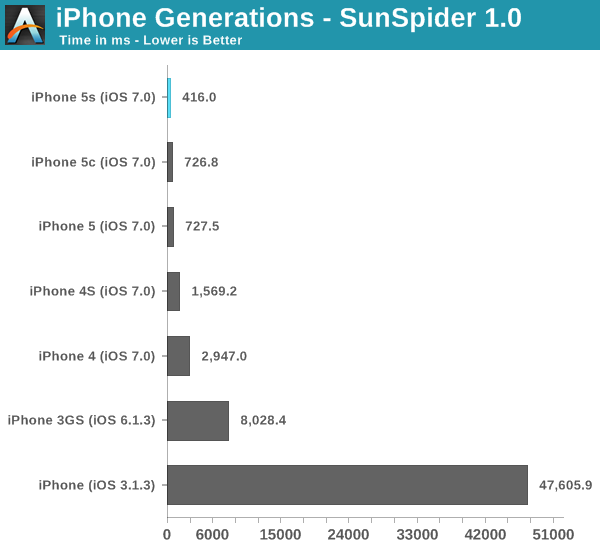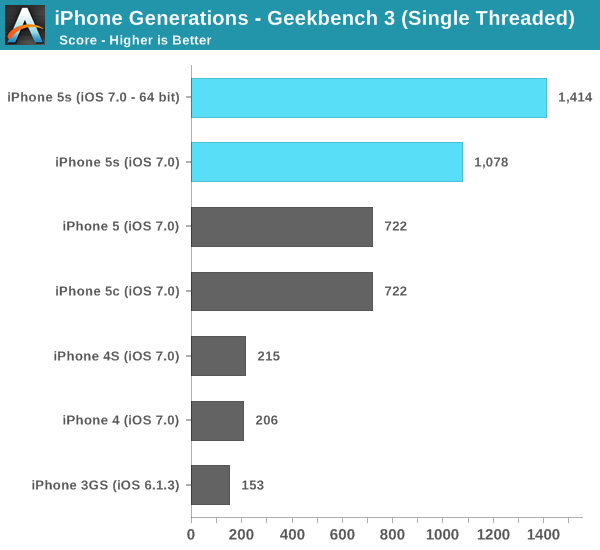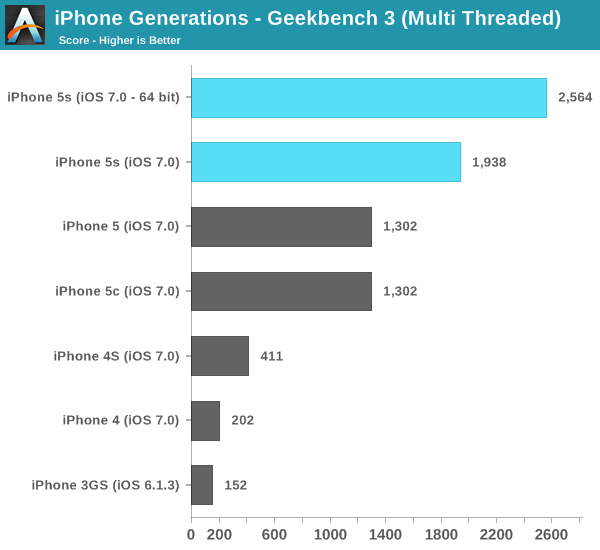The iPhone 5s Review
by Anand Lal Shimpi on September 17, 2013 9:01 PM EST- Posted in
- Smartphones
- Apple
- Mobile
- iPhone
- iPhone 5S
iPhone Performance Across Generations

Performance improved by a factor of 100x compared to the original iPhone. You can cut that in half if the iPhone could run iOS 4. Needless to say, Apple's CPU performance estimates aren't unreasonable. We've come a long way since the days when ARM11 cores were good enough.
Even compared to a relatively modern phone like the iPhone 4, the jump to a 5s is huge. The gap isn't quite at the level of an order of magnitude, but it's quickly approaching it. Using the single core iPhone 4 under iOS 7 just feels incredibly slow. Starting with the 4S things get a lot better, but I'd say the iPhone 4 is at the point now where it's starting to feel too slow even for normal consumers (at least with iOS 7 installed).

Browsermark 2.0 gives us a good indication of less CPU bound performance gains. Here we see over a 5x increase in performance compared to the original iPhone, and an 83% increase compared to the iPhone 4.
I wanted to have a closer look at raw CPU performance so I turned to Geekbench 3. Unfortunately Geekbench 3 won't run on anything older than iOS 6, so the original iPhone bows out of this test.

Single threaded performance scaled by roughly 9x from the 3GS to the iPhone 5s. The improvement since the iPhone 4/4S days is around 6.5x. Single threaded performance often influences snappiness and UI speed/feel, so it's definitely an important vector to scale across.

Take into account multithreaded performance and the increase over the 3GS is even bigger, almost 17x now.
The only 3D test I could get to reliably run across all of the platforms (outside the original iPhone) was Basemark X. Again I had issues getting Basemark X running in offscreen mode on iOS 7 so all of the tests here are run at each device's native resolution. In the case of the 3GS to 4 transition, that means a performance regression as the 3GS had a much lower display resolution to deal with.

Apple has scaled GPU performance pretty much in line with CPU performance over the years. The 5s scores 15x the frame rate of the iPhone 4, at a higher resolution too.
iPhone 5s vs. Bay Trail
I couldn't help but run Intel's current favorite mobile benchmark on the iPhone 5s. WebXPRT by Principled Technologies is a collection of browser based benchmarks that use HTML5 and js to simulate a number of workloads (photo editing, face detection, stocks dashboard and offline notes).

Granted we're comparing across platforms/browsers here, but the 5s as a platform does extremely well in Intel's favorite benchmark. The 5c by comparison performs a lot more like what we'd expect from a smartphone platform. The iPhone 5s is in a league of its own here. While I don't expect performance equalling the Atom Z3770 across the board, the fact that Apple is getting this close (with two fewer cores at that) is a testament to the work done in Cupertino.
At its launch event Apple claimed the A7 offered desktop class CPU performance. If it really is performance competitive with Bay Trail, I think that statement is a fair one to make. We're not talking about Haswell or even Ivy Bridge levels of desktop performance, but rather something close to mobile Core 2 Duo class. I've broken down the subtests in the table below:
| WebXPRT Performance (time in ms, lower is better) | ||||||
| Chrome/Mobile Safari | Photo Effects | Face Detection | Stocks | Offline Notes | ||
| Apple iPhone 5s (Apple A7 1.3GHz) | 878.9 ms | 1831.4 ms | 436.1 ms | 604.6 ms | ||
| Intel Bay Trail FFRD (Atom Z3770 1.46GHz) | 693.5 ms | 1557.0 ms | 542.9 ms | 737.3 ms | ||
| AMD A4-5000 (1.5GHz) | 411.2 ms | 2349.5 ms | 719.1 ms | 880.7 ms | ||
| Apple iPhone 5c (Apple A6 1.3GHz) | 1987.6 ms | 4119.6 ms | 763.6 ms | 1747.6 ms | ||
It's not a clean sweep for the iPhone 5s, but keep in mind that we are comparing to the best AMD and Intel have to offer in this space. I suspect part of why this is close is because both of those companies have been holding back a bit (there's no rush to build the fastest low margin parts), but it doesn't change reality.










464 Comments
View All Comments
robbie rob - Sunday, September 22, 2013 - link
@justacousinNot sure whats to be said. Samsung didn't design the A7, but unfortunately for ANY company in the USA its cheaper to have most things made in asia even though they aren't designed there. Samsung fabricates many types chips and ram in its plants that it doesn't necessarily design. Unfortunately for American's this is why may products like the Xbox are made in China.
Abhip30 - Tuesday, September 24, 2013 - link
Samsung just makes them for apple.They are actually glorified foxconn. Apple provides them blueprints and samsung manufactures it. They just follow apple's instructions.Origin64 - Monday, September 23, 2013 - link
Still no HD-Ready resolution (in 2013, really?) but we have a fingerprint scanner. A shame it's hackable and fingerprints aren't safe in general, where just a few weeks ago I read about a new identification technique that made use of an infrared scan of blood vessels in your face. More unique, harder to copy. Not that that'd be good to have, the NSA will still get their fingers on those biometrics.darkcrayon - Monday, September 23, 2013 - link
Going to 720p on a 4" phone wouldn't make much difference.robbie rob - Monday, September 23, 2013 - link
Fingerprint technology is in its infancy in consumer products. Any hacking of the fingerprint scan helps Apple and the industry. Apple will be able to patch vulnerabilities found by the best of the best. My thoughts are.. Overall, no one wants my fingerprints or yours. For the millions of people out there who have an iPhone most aren't worth the work or time. To me that means I'm just fine using it to log into a phone or make a purchase on iTunes. The truth is it would be easier and more likely for someone to break into your bank account online. No one needs a fingerprint to do that.Promptneutron - Monday, September 23, 2013 - link
Another comprehensive, detailed but readable review. Anand, you produce (by some margin) the finest tech reviews on the web. Even my wife (who is a tech vacuum) read this and wants an iphone 5s..and she's not alone..;)...thank you and top work (again).NerdT - Monday, September 23, 2013 - link
All of these graphics performance comparisions (except the off-screen ones) are incorrect and absolutly miss-leading. The reason is that most of the other phones have a 1080p display which has 2.8x higher resolution that iPhone 5s! That being said, all on-screen scores will get bumped up by about the same scale for iPhone because they are calculated based on FPS only, and the frames are render the the device resolution. This is a wrong benchmarking because you are not having an apple to apple comparision. I would have expected a much higher quality report from Anandtech! Please go ahead and correct your report and prevent miss-leading information.darkcrayon - Monday, September 23, 2013 - link
As you even said, both onscreen and offscreen tests were shown, and the resolution difference was noted. They even have the iPhone 5 in the tests for the truest "apple to apple" comparison possible. I think you're grasping at straws here.robbie rob - Monday, September 23, 2013 - link
"off screen" resolutions FPS was shown ..AEdouard - Monday, September 30, 2013 - link
Hey NerdT. For a nerd, you sure don't know how to interpret charts. What do you think the offscreen tests are for? It's to eliminate the effect of display resolution. In those tests, the iPhone performed better, generally, then all other phones. The only processors that beat it where SOCs put inside tablets (where their performance can be increased).And beyond, that, isn't the main point to be able to see how the phone will perform in real life, which is why tests at the phone's resolution matter too.